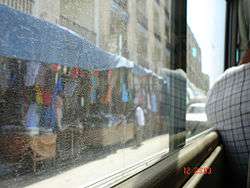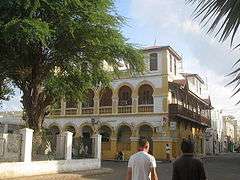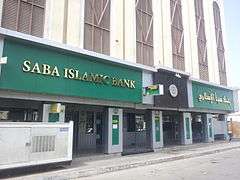Economy of Djibouti
The economy of Djibouti is derived in large part from its strategic location on the Red Sea. Djibouti is mostly barren, with little development in the agricultural and industrial sectors. The country has a harsh climate, a largely unskilled labour force, and limited natural resources. The country's most important economic asset is its strategic location connecting the Red Sea and the Gulf of Aden. As such, Djibouti's economy is commanded by the services sector, providing services as both a transit port for the region and as an international transshipment and refueling centre.
 Port of Djibouti | |
| Currency | Djiboutian franc (DJF) |
|---|---|
| Calendar year | |
Trade organisations | AL, AU, CEN-SAD, IGAD |
| Statistics | |
| GDP | |
GDP growth |
|
GDP per capita | |
GDP by sector |
|
| 0.148% (2018)[1] | |
Population below poverty line | 23% |
Labour force | 294,600 (2012 est.) |
Labour force by occupation |
|
| Unemployment | 40% (2017 est.) |
Main industries | Dairy, Fishing, Salt, Construction, Mining |
| External | |
| Exports | $155.5 million (2017 est.) |
Export goods | Reexports, Hides and skins, Coffee, Scrap metal |
Main export partners | |
| Imports | $1.172 billion (2017 est.) |
Import goods | Machinery and Equipment, Foodstuffs, Beverages, Chemicals, Petroleum products, Consumer Goods |
Main import partners | |
| Public finances | |
| 85% (2017 est.) | |
| Revenues | $615 million |
| Expenses | $860 million |
From 1991 to 1994, Djibouti experienced a civil war which had devastating effects on the economy. Since then, the country has benefited from political stability. In recent years, Djibouti has seen significant improvement in macroeconomic stability, with its annual gross domestic product improving at an average of over 3 percent since 2003. This comes after a decade of negative or low growth. This is attributed to fiscal adjustment measures aimed at improving public financing, as well as reforms in port management.
Despite the recent modest and stable growth, Djibouti is faced with many economic challenges, particularly job creation and poverty reduction. With an average annual population growth rate of 2.5 percent, the economy cannot significantly benefit national income per capita growth. Unemployment is extremely high at over 43 percent and is a major contributor to widespread poverty. Efforts are needed in creating conditions that will enhance private sector development and accumulate human capital. These conditions can be achieved through improvements in macroeconomic and fiscal framework, public administration, and labour market flexibility.[8]
Djibouti was ranked the 177th safest investment destination in the world in the March 2011 Euromoney Country Risk rankings.[9]
Economic performance

Djibouti has experienced stable economic growth in recent years as a result of achievements in macroeconomic adjustment efforts. Fiscal adjustment measures included downsizing the civil service, implementing a pension reform that placed the system on a much stronger financial footing, and strengthening public expenditure institutions. From 2003 to 2005, annual real GDP growth averaged 3.1 percent driven by good performance in the services sector and strong consumption. Inflation has been kept low (only 1 percent in 2004, compared with 2.2 percent in 2003), due to the fixed peg of the Djibouti franc to the US dollar. However, as mentioned above, unemployment has remained high at over 40 percent in recent years. Djibouti's gross domestic product expanded by an average of more than 6 percent per year, from US$341 million in 1985 to US$1.5 billion in 2015.
The government fiscal balance is in deficit because the government has not been able to raise sufficient tax revenues to cover expenses. In 2004, a substantial increase in expenditure resulted in a deterioration of the fiscal position. As a result, the government deficit increased to US$17 million in 2004 from US$7 million in 2003. But improvement in expenditure management brought down the fiscal deficit to US$11 million in 2005.[8]
Balance of payments
Djibouti's merchandise trade balance has shown a large deficit. This is due to the country's enormous need for imports and narrow base of exports. Although Djibouti runs a substantial surplus in its services balance, the surplus has been smaller than the deficit in the merchandise trade balance. As a result, Djibouti's current account balance has been in deficit. There is very limited information for Djibouti's current account; the country's merchandise trade deficit was estimated at US$737 million in 2004.[8]
Regional situation
Positioned on a primary shipping lane between the Gulf of Aden and the Red Sea, Djibouti holds considerable strategic value in the international trade and shipping industries. The facilities of the Port of Djibouti are important to sea transportation companies for fuel bunkering and refuelling. Its transport facilities are used by several landlocked African countries for the re-export of their goods. Djibouti earns transit taxes and harbour fees from this trade, these form the bulk of government revenue. Threats of pirates patrolling the Gulf of Aden, off the coast of Somalia, with the intentions of capturing large cargo ships, oil, and chemical tankers has created the need for larger nations such as the United States, France, and Japan to embed logistics bases or military camps from which they can defend their freight from piracy. The port of Djibouti functions as a small French naval facility, and the United States has also stationed hundreds of troops in Camp Lemonnier, Djibouti, its only African base, in an effort to counter terrorism in the region.[8] Recently China has stated they are in talks to build “logistics facilities” in Obock to provide support peacekeeping and anti-piracy missions near Somalia and the Gulf of Aden.[10] Additional international presence will increase both Djibouti's economic value as well its strategic importance in the region.
Macro-economic trend
This is a chart of trend of gross domestic product of Djibouti at market prices estimated by the International Monetary Fund with figures in millions of Djiboutian francs.
| Year | Gross Domestic Product | US Dollar Exchange | Inflation Index (2000=100) |
|---|---|---|---|
| 1980 | 54,969 | 177.89 Djiboutian Francs | 44 |
| 1985 | 64,988 | 177.56 Djiboutian Francs | 49 |
| 1990 | 80,388 | 177.84 Djiboutian Francs | 70 |
| 1995 | 88,456 | 177.62 Djiboutian Francs | 90 |
| 2000 | 97,965 | 177.79 Djiboutian Francs | 100 |
| 2005 | 124,770 | 177.73 Djiboutian Francs | 111 |
For purchasing power parity comparisons, the US dollar is exchanged at 76.03 Djiboutian francs. Mean wages were $1.30 per person-hour in 2009.
The following table shows the main economic indicators in 1980–2017.[11]
| Year | 1992 | 1995 | 2000 | 2005 | 2006 | 2007 | 2008 | 2009 | 2010 | 2011 | 2012 | 2013 | 2014 | 2015 | 2016 | 2017 |
|---|---|---|---|---|---|---|---|---|---|---|---|---|---|---|---|---|
| GDP in $ (PPP) |
1.20 Bln. | 1.14 Bln. | 1.22 Bln. | 1.58 Bln. | 1.70 Bln. | 1.84 Bln. | 1.98 Bln. | 2.03 Bln. | 2.14 Bln. | 2.34 Bln. | 2.50 Bln. | 2.67 Bln. | 2.88 Bln. | 3.10 Bln. | 3.34 Bln. | 3.63 Bln. |
| GDP per capita in $ (PPP) |
2,349 | 2,049 | 1,915 | 2,153 | 2,263 | 2,373 | 2,490 | 2,480 | 2,544 | 2,710 | 2,814 | 2,921 | 3,066 | 3,211 | 3,369 | 3,559 |
| GDP growth (real) |
0.6 % | −3.5 % | 0.7 % | 3.1 % | 4.8 % | 5.0 % | 5.8 % | 1.6 % | 4.1 % | 7.3 % | 4.8 % | 5.0 % | 6.0 % | 6.5 % | 6.5 % | 6.7 % |
| Inflation (in Percent) |
3.4 % | 4.9 % | 2.0 % | 3.1 % | 3.5 % | 5.0 % | 12.0 % | 1.7 % | 4.0 % | 5.1 % | 3.7 % | 2.4 % | 2.9 % | 2.1 % | 2.7 % | 0.7 % |
| Government debt (Pct. of GDP) |
– | – | 58 % | 60 % | 59 % | 57 % | 59 % | 60 % | 52 % | 45 % | 43 % | 43 % | 39 % | 34 % | 32 % | 31 % |
Investment climate
Background

Djibouti's economy is based on service activities connected with the country's strategic location and status as a free trade zone in the Horn of Africa. Two-thirds of inhabitants live in the capital and the remainder of the populace is mostly nomadic herders. Low amounts of rainfall limit crop production to fruits and vegetables, and requiring most food to be imported. The government provides services as both a transit port for the region and an international transshipment and refueling centre. Djibouti has few natural resources and little industry. All of these factors contribute to its heavy dependence on foreign assistance to help support its balance of payments and to finance development projects.[12]
An unemployment rate of 50 percent continues to be a major problem. Inflation is not a concern, however, because of the fixed tie of the franc to the US dollar. Per capita consumption dropped an estimated 35 percent over the last seven years because of recession, civil war, and a high population growth rate. Faced with a multitude of economic difficulties, the government has fallen in arrears on long-term external debt and has been struggling to meet the stipulations of foreign aid donors.[13]
Openness to foreign investment
The government of Djibouti welcomes all foreign direct investment. Djibouti's assets include a strategic geographic location, an open trade regime, a stable currency, substantial tax breaks and other incentives. Potential areas of investment include Djibouti's port and the telecommunications sectors. President Ismail Omar Guellehh first elected in 1999, has named privatization, economic reform, and increased foreign investment as top priorities for his government. The president pledged to seek the help of the international private sector to develop the country's infrastructure.
Djibouti has no major laws that would discourage incoming foreign investment. In principle there is no screening of investment or other discriminatory mechanisms. That said, certain sectors, most notably public utilities, are state owned and some parts are not currently open to investors. Conditions of the structural adjustment agreement recently signed by Djibouti and the International Monetary Fund stipulate increased privatization of parastatal and government-owned monopolies. There are no patent laws in Djibouti.[14]
As in most African nations, access to licenses and approvals is complicated not so much by law as by administrative procedures. In Djibouti, the administrative process has been characterized as a form of 'circular dependency.' For example, the finance ministry will issue a license only if an investor possesses an approved investor visa, while the interior ministry will only issue an investor visa to a licensed business. The Djiboutian government is increasingly realizing the importance of establishing a one-stop shop to facilitate the investment process.[8]
Gender
In May 2015 Choukri Djibah, Director of Gender in the Department of Women and Family, launched the project SIHA (Strategic Initiative for the Horn of Africa) designed to support and reinforce the economic capacity of women in Djibouti, funded with a grant from the European Union of 28 Million Djibouti francs.[15]
Sectors
Trade

Principal exports from the region transiting Djibouti are coffee, salt, hides, dried beans, cereals, other agricultural products, chalk, and wax. Djibouti itself has few exports, and the majority of its imports come from France. Most imports are consumed in Djibouti and the remainder goes to Ethiopia and Somalia. Djibouti's unfavourable balance of trade is offset partially by invisible earnings such as transit taxes and harbour dues. In 1999, U.S. exports to Djibouti totalled $26.7 million while U.S. imports from Djibouti were less than $1 million. The City of Djibouti has the only paved airport in the republic.
Tourism
In 2013, 63,000 foreign tourists visited Djibouti, Djibouti City is the principal tourist destination for visitors, revenues from tourism fell just US$43 million in 2013.
See also
- Djibouti and the World Bank
- IMF Relations with Djibouti
- List of companies based in Djibouti
- United Nations Economic Commission for Africa
References
- "World Economic Outlook Database, October 2019". IMF.org. International Monetary Fund. Retrieved 3 November 2019.
- "Middle East and North Africa Economic Update, April 2020 : How Transparency Can Help the Middle East and North Africa". openknowledge.worldbank.org. World Bank. p. 10. Retrieved 10 April 2020.
- "Human Development Index (HDI)". hdr.undp.org. HDRO (Human Development Report Office) United Nations Development Programme. Retrieved 11 December 2019.
- "Inequality-adjusted Human Development Index (IHDI)". hdr.undp.org. HDRO (Human Development Report Office) United Nations Development Programme. Retrieved 11 December 2019.
- "Ease of Doing Business in Djibouti". Doingbusiness.org. Retrieved 24 January 2017.
- "Export Partners of Djibouti". CIA World Factbook. 2013. Retrieved 11 May 2015.
- "Economy of Djibouti". 2014.
- Country Watch
- "Euromoney Country Risk". Euromoney Country Risk. Euromoney Institutional Investor PLC. Retrieved 15 August 2011.
- "China's Djibouti military base: logistics facility or geopolitical platform?". South China Morning Post. 1 October 2017. Retrieved 27 October 2019.
- "Report for Selected Countries and Subjects". Retrieved 29 August 2018.
- "Djibouti Economy Djiboutian Economy, business opportunities in Djibouti government Djibouti business opportunities import and export opportunities". www.globaltenders.com. Retrieved 27 May 2020.
- Country Watch
- Bill Anderson
- "Lettre d'information UE-Djibouti n°5". Issuu. Retrieved 9 March 2020.
External links
- Economy of Djibouti at Curlie
- Djibouti latest trade data on ITC Trade Map
- Richard Labelle, "Djibouti ICT strategy and action plan", 28 May 2003
- African Development Bank, "Djibouti: Results-based country strategy paper, 2007-2010", October 2007
- Le système informel de transferts de fonds et le mécanisme automatique du Currency Board : complémentarité ou antagonisme ? Le cas des transferts des hawalas à Djibouti
